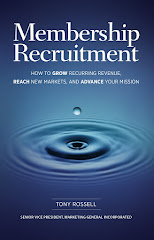One of the most rapidly adopted tools in association marketing
today is data analytics. It provides the
knowledge to segment members and customers, target offers and messages, and maximize
efficiency.
Here are some methods that are making a big difference for
associations right now.
- Recruitment Modeling – Many factors serve as either positive or negative predictors of whether or not a member will join an association including previous buying behavior (frequency and recency), non-monetary interactions, list source, number of previous recruitment contacts, and company or personal demographics. By analyzing and scoring how each of these factors impacts someone’s likelihood of joining and rolling up the scores, a prospective membership file can be arrayed from the most likely to the least likely person to join and then broken down into segments or deciles. Not surprisingly the top deciles may perform at double the return of the overall file producing outstanding results.
- Membership Retention Key Performance Indicators (KPI) – Every interaction that a current member has with the association is a predictor of whether or not they will renew. Data analytics can help to define which behaviors or interactions a member takes are most likely to result in them continuing with the association. Knowing this can drive an engagement strategy and move members to these behaviors. Interestingly, conference attendance is often a negative predictor of renewal.
- Member and Customer Ranking - It is not at all unusual to have 20 percent of customers or members produce 80 percent of sales. Identifying who these customers are is a great use of data analytics. The method to identify the very best performing customers involves building an algorithm around three coordinates: Recency, Frequency, and Monetary Amount (RFM). This method highlights a customer who recently made several purchases as a better prospect over one who made a very large purchase several years ago. Focusing time, resources, and attention on the best members and customers will pay off.
- Missionary Products and Member Migration - Whether it is understood or not, most associations have one product line that is typically the very first financial transaction between the association and an individual or company. Data analytics can define this product or service and knowing this allows an association to focus marketing resources on that “missionary” or introductory product and service. In addition to identifying the introductory product – whether it is conference registration, membership, or certification – further analysis can track secondary and tertiary purchases to help understand the product migration path for the association. All of this enables a marketing team to help an individual successfully navigate the opportunities presented by an association and reduce marketing static and conflicting messages.
There are obviously far more opportunities than listed here to
analyze data in order to maximize marketing effectiveness. In fact, the only limits are having the data
available and defining the knowledge that you want to gain from the data.
And even if all of the needed data is not on hand,
demographic and firmographic data appends are available with a wealth of
information to enhance any database. Then
for success in data analytics it is important to define what specific questions
that you want the analysis to answer before you start the analytics process.









